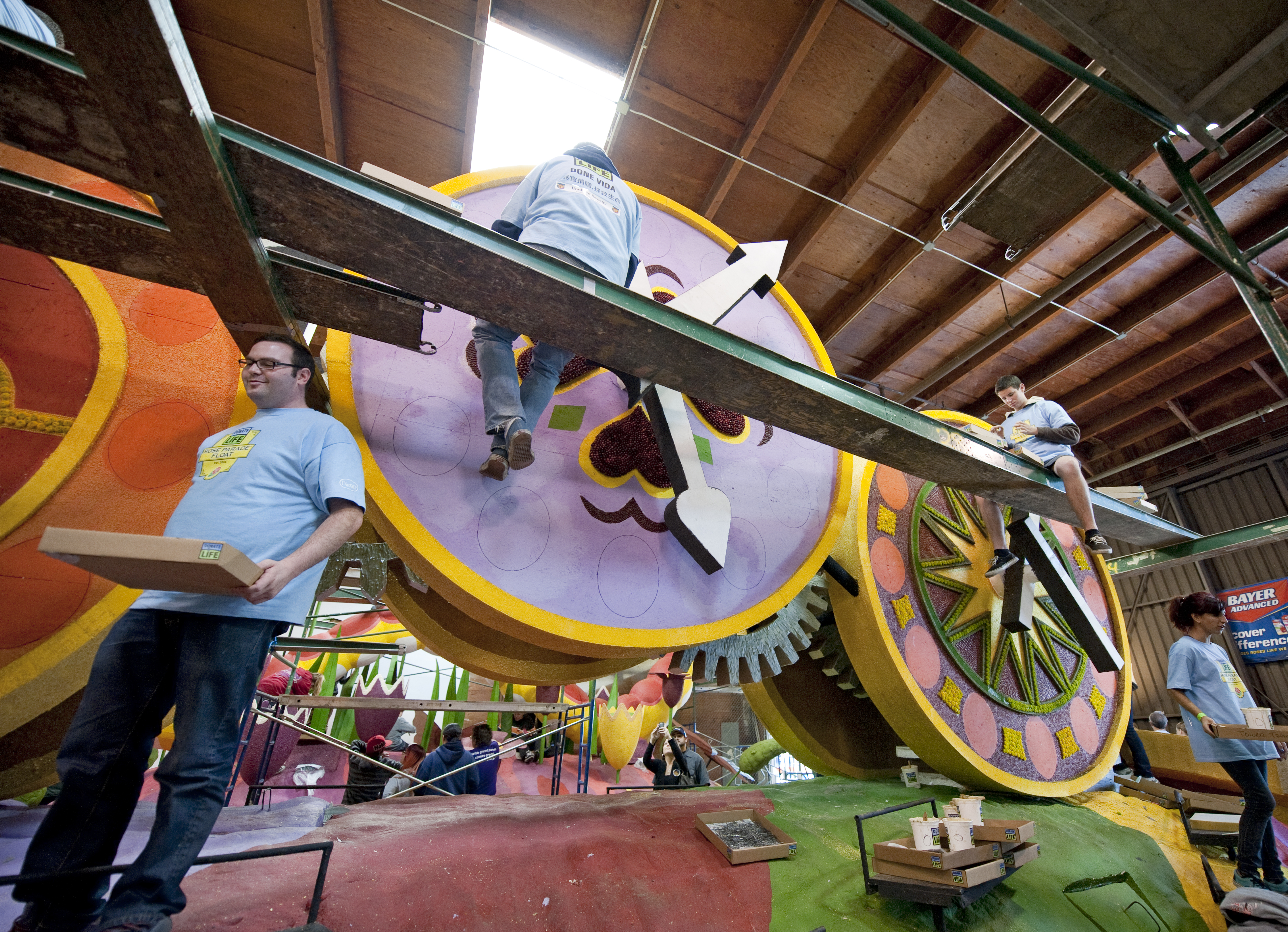UCLA Health System sponsors Donate Life float in Rose Parade to honor organ donors, recipients

Volunteers work on decorating the floral clocks that adorned the float featured in the Rose Parade on Jan. 2.
By Samantha Masunaga
Jan. 9, 2012 1:15 a.m.

UCLA Health System

Volunteer Joy Weller holds up a floral portrait of organ donor Jose Gutierrez, whose portrait was sponsored by the UCLA Health System.
The buttons say it all.
Stephanie McMackin never met the three young men whose photos she wore pinned to her shirt. But it is because of organ donors like them that she is alive.
McMackin honored their memories as one of the float riders on the Donate Life Rose Parade float, partially sponsored by UCLA.
The float’s theme? One More Day.
“It was the ride of a lifetime, such an emotional experience,” said McMackin, a 62-year-old Fullerton resident.
The float drew tears from both judges and spectators. One man along the parade route even lifted his shirt to reveal his own transplant scar, showing support for the float’s message of organ donation.
McMackin’s experience was much different from her original Rose Parade debut in 1967, when she rode on a Western-themed float as Miss Monterey Park.
“I remember it being just happy, happy,” she said. “Riding on the float was cool and it was fun to talk about it with my friends.”
This carefree attitude would be changed by more serious circumstances just three years later.
During a waterskiing trip, her skin started to turn yellow. It was the first sign of a congenital liver disease that would dictate her life until 1990, when she got the call that a liver was available.
“When you’re waiting for a transplant, you’re on the edge,” she said. “But I was determined to survive.”
She received the transplant at the Ronald Reagan UCLA Medical Center, which she also credits with keeping her alive until she could receive an organ.
McMackin is just one of several float riders and volunteers with intimate ties to the university.
In the beginning of December, volunteers congregated in Pasadena to help decorate the 17-by-55-foot float with a 33-foot clock tower and six clocks bearing floral portraits of organ donors. Up to 80 volunteers would go to the decorating headquarters each day to cut petals into tiny pieces or paste cranberries onto clock faces.
Tedious work, but volunteers don’t always see it that way.
“We learn something new every year,” said Joy Weller, a volunteer from Yucaipa, Calif. who has worked on the float for the past four years.
Camaraderie between the various floats’ volunteers is high. The cranberries adorning this year’s float were a suggestion from volunteers from the Trader Joe’s float team. In exchange, some of the Donate Life volunteers helped them finish their decorating, Weller said.
The float’s design was inspired by clock towers around the world. Five of the clocks run forward, representing the time given to organ recipients. One of the clocks runs backward, signifying the time organ donors’ families wish they could relive with their loved ones.
One of these floragraphs was an onion seed and dried strawberry depiction of Jose Gutierrez, a father from Fillmore, Calif., whose family chose to donate his organs after he suffered severe brain trauma. His portrait was sponsored by the UCLA Health System, which has been one of the float’s sponsors since its debut eight years ago, said Roxanne Moster, spokeswoman for the UCLA Health System.
“The Donate Life float is a beautiful, touching and uplifting way to reach out to millions of viewers across America … about how organ donation can change lives,” Moster said.
Leiauna Anderson, a 1996 UCLA alumna, former Anderson School of Management and UCLA Lab School employee and float decorator, came to rely on her alma mater when she suddenly developed kidney failure in her seventh month of pregnancy.
While getting ready for bed one night in January 2006, Anderson noticed her baby was not kicking inside her. Her observation soon snowballed into a serious situation.
At the hospital, doctors realized the baby had no heartbeat. At the same time, Anderson’s blood pressure skyrocketed, then dropped as she experienced internal bleeding. She was taken to the UCLA Medical Center, where she was told she needed a liver transplant to live. Anderson, then 32, had never had problems with her liver.
After two separate transplants, Anderson was cured. Today, she has a 3-year-old son named Rex, conceived through a surrogate ““ Anderson’s sister-in-law ““ because it is too dangerous for the 38-year-old mother to become pregnant.
She now volunteers regularly with OneLegacy, a nonprofit organ and tissue organization that coordinates the Donate Life campaign, to promote organ donation and has decorated the float for a number of years.
“We need to think about our community and see the need,” she said. “It’s not until someone we know has the need that we start to rally and advocate for organ donation.”
While walking briskly through aisles flanked by tables of cut flowers at the decorating headquarters near the Rose Bowl, Anderson explained that this year’s warm weather presented challenges for the volunteers. To combat the temperature, decorators placed the flowers in vials of water to prevent them from drying out before the big day.
One of the most meaningful parts of the float for Anderson is the rose dedication garden, where organ recipients and family members can place a flower in memory of a donor. Though she did not place a rose for her 19-year-old donor, Anderson keeps in regular contact with the woman’s family.
“When we first met, her dad said it was like hugging his daughter,” Anderson said. “That’s when it became real that someone had to die for me to live.”

